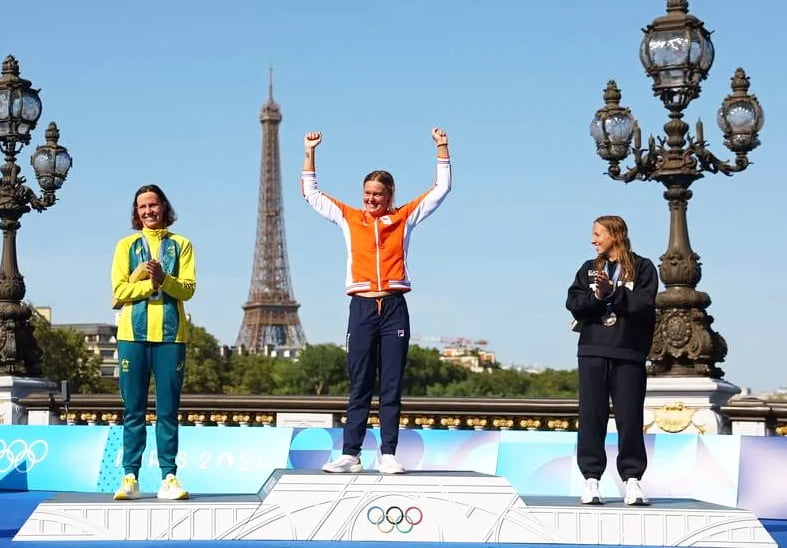No results available
ResetMoesha Johnston and Kyle Lee comment on their race, the river conditions, and their Olympic experience.
The 10km marathon swims at the 2024 Paris Olympic Games, held in the Seine River, presented unique challenges for all competitors. The course blended iconic Parisian scenery with the unpredictable nature of open water competition.
For Australia’s Moesha Johnston and Kyle Lee, the race was both a battle against their competitors and against the river’s strong currents and obstacles.
Suzie Ryan caught up with Johnston and Lee post-Olympics to hear about the race and their Olympic experience.
Moesha Johnston delivered a standout performance in the women’s 10km marathon swim, securing a silver medal.
Ms Johnston had prepared meticulously for the conditions, training specifically with the Seine’s currents in mind.
“In the lead-up, I trained with the current in mind,” said Ms Johnston, emphasising the importance of adapting to open water’s ever-changing dynamics.
“It was challenging, but I enjoyed it. It’s what makes open water so fun; every race is different, conditions are never the same every time, and it makes you think and plan with the knowledge you have.”
Ms Johnston faced the current and physical challenges along the course, swimming close to the walls of the Seine and through patches of reeds, which posed unique obstacles.
“Some of the hanging plants had sharp stems, so a lot of the girls came away with nasty cuts on our right arms,” said Ms Johnston.
“They decided to cut them before the boys race, so they were lucky and didn’t have to contend with them.
Despite these hurdles, Ms Johnston was pleased with her adaptability during the race, noting, “I didn’t stick to the race plan, but I adapted to what I was seeing in the race to ensure I had a better performance.”
Reflecting on her achievement, Ms Johnston expressed her delight at reaching the podium and claiming a Silver medal.
“I knew a podium was a potential outcome, but my open water experience is still limited compared to most of the girls in my race, said Ms Johnston.
“Individual podium is something I’ve been working towards for the past couple of years, but I wasn’t sure it was something I’d achieve so soon in my open water career, so I am very pleased with the outcome of a silver medal.”

In the men’s 10km marathon swim, Kyle Lee battled through to finish 13th in a highly competitive field.
Unlike Johnston, Lee had not specifically trained in conditions similar to the Seine.
“I didn’t really train for the current conditions that we would face in the Seine,” said Mr Lee.
“Where I train, we don’t have many naturally strong currents that would simulate racing in the river Seine, so we didn’t have many options.”
The experience of swimming against the river’s current proved to be a tough challenge for all the swimmers including Mr Lee.
“Swimming against the current was pretty tough, especially in the middle of the river when we had to go around the turn cans to come back,” said Mr Lee.
“Lots of swimmers took the strategic position of staying close to the side of the river where the current was weaker.”
Mr Lee approached the race with a flexible strategy, making decisions in real-time rather than adhering to a strict race plan.
“Usually when I race open water, I don’t have a strict race plan as there are so many variables,” said Mr Lee.
“I just try to make the best decisions with the information I have at the time and that’s what I did on the day at the Olympics.”
Despite the tough conditions, Mr Lee was content with his performance.
“I was happy with my race as going in I knew my coach and I had given all that we could.
“In the race, I left everything I had out there and couldn’t do anything more.”
Alongside Ms Johnston & Mr Lee, the Australian team had a strong presence, with Nick Sloman joining Lee in the men’s race, finishing in a commendable 8th place.
Mr Sloman, who had prepared extensively, managed to stay with the lead pack through much of the race, demonstrating his competitive edge in the turbulent waters of the Seine.
His top-10 finish was a testament to his skill and adaptability under challenging conditions.
In the women’s event, Chelsea Gubecka, a seasoned marathon swimmer, finished 15th. Ms Gubecka contended with the unique challenges posed by the Seine, including navigating tight spaces along the river walls and adjusting to the varying currents.
While Ms Gubecka had hoped for a stronger finish, she took the experience in stride, stating, “Every race is a learning experience, especially when you’re up against the best in the world in such unique conditions.”
Both Johnston and Lee took extensive precautions regarding the widely discussed water quality issues in the Seine.
“We were monitoring the water quality every time the results were released and comparing it to weather conditions to know the general trend of how the quality of the water was fluctuating, said Ms Johnston.”
“We also had a great medical team with a plan to keep us healthy, including an oral vaccine and antibiotics.”
Mr Lee echoed similar sentiments, noting that they took antibiotics as a precaution, which helped them avoid any health issues post-race.
For Ms Johnston and Mr Lee, the Olympic experience blended intense competition and personal achievement.
Ms Johnston described it as “wild, intense, stressful, and absolutely out-of-this-world,” while Mr Lee highlighted the joy of having his family and friends present, saying, “The Olympic experience was amazing, and I tried to soak up as much of the village experience as I could.”
All four of Australia’s marathon swimmers showcased their resilience and adaptability in the face of the Seine’s challenges, making their Olympic debuts memorable and setting a solid foundation for future international competitions.
No results available
Reset




Copyright © 1999-2024 oceanswims.com. All rights reserved.
‘OCEANFIT is a registered trademark of OceanFit Pty Ltd.